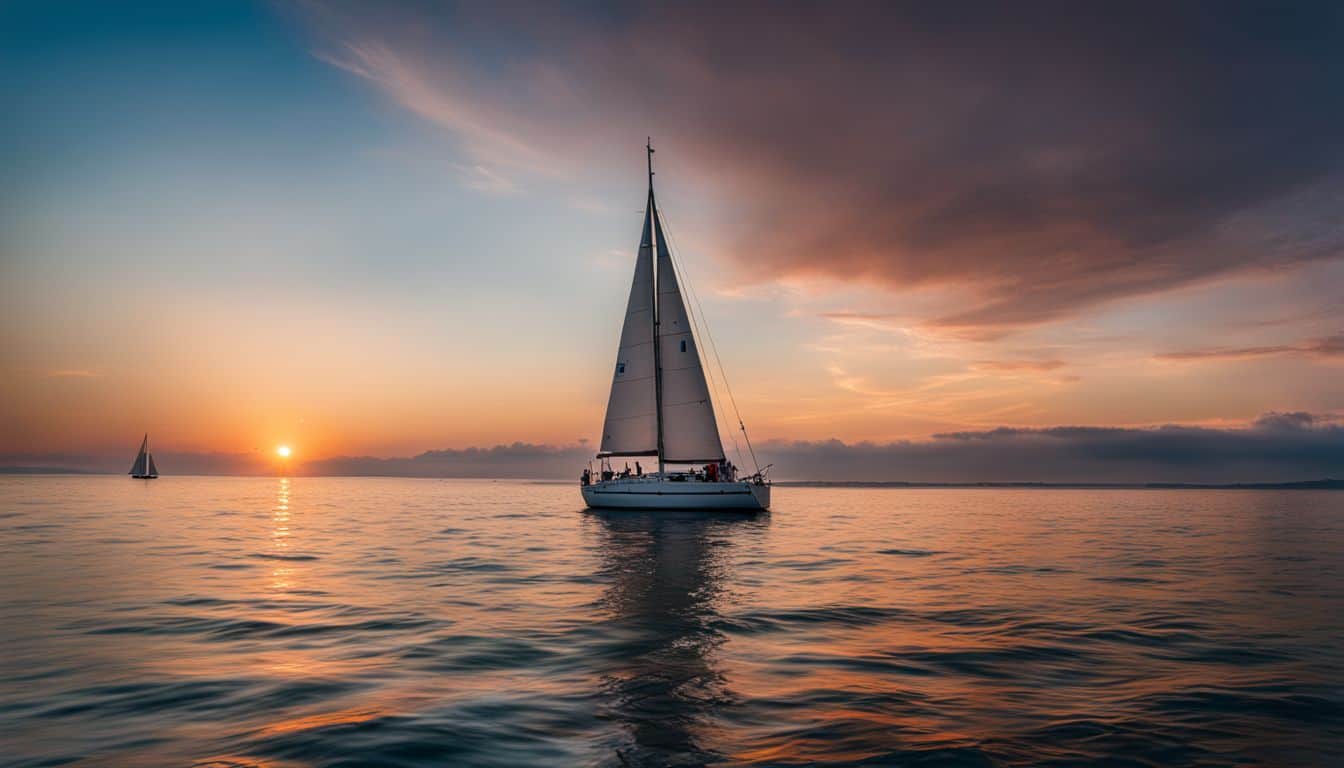Imagine you’re on a boat, and suddenly you need help. Knowing how to signal for rescue is crucial in such emergencies. This article will guide you through creating effective visual and audio SOS signals so you can be prepared in times of distress.
Read on; safety awaits!
Table of Contents
- Understanding SOS Distress Signals
- Visual Distress Signals: Types and Uses
- Crafting Effective Audio SOS Distress Signals
- Conclusion
- How Can I Incorporate a Ferrocerium Rod into Visual and Audio Distress Signals?
- FAQs
- What are the main types of visual distress signals for boaters?
- When should I use an audio signal to call for help?
- How do EPIRBs assist in rescue operations?
- What does u0022PAN PANu0022 mean on marine radios?
- Can I use any light as a distress signal at night?
- Is it important to know about navigation lights and code flags when boating?
Key Takeaways
- SOS distress signals are vital for communication in emergencies on water; they can be audio or visual, like flares, flags, or sound patterns.
- Pyrotechnic devices such as parachute flares and multi-star flares are effective at night, while orange smoke signals work well during the day.
- The ‘S.O.S.’ signal using Morse code — three short blasts followed by three long blasts and then three short ones — is a universal audio distress call that can be made with horns or whistles.
- Non-pyrotechnic signaling methods include electric lights flashing S.O.S. and hand-held orange distress cloths to indicate trouble without fire risks.
- Boaters should have the necessary emergency signaling equipment on board, know how to use it correctly and understand marine safety regulations for effective rescue operations.
Understanding SOS Distress Signals

In the realm of emergencies in open waters or remote locations, SOS distress signals are pivotal, bridging the gap between dire situations and potential rescue. Grasping their significance and modes—visual and audio—can mean distinguishing between being overlooked or swiftly found by search and rescue teams.
Definition and Purpose
An SOS distress signal is a universal sign of emergency, signaling that someone is in danger and needs immediate help. These signals can be visual or auditory, ranging from the well-known Morse Code SOS sent via sound or light flashes to flares launched into the sky.
The purpose of an SOS signal is clear: it grabs attention fast and prompts search and rescue efforts. Boaters must know how to send out these signals, as outlined by Small Vessel Regulations, so they’re prepared during life-threatening situations.
Visual and audio distress signals serve as critical lifelines on waterways across the globe. From dye markers creating vivid spots in the sea to piercing whistles cutting through silence, boaters use these tools to communicate their plight.
With legal requirements for recognizing and exhibiting such signals correctly, knowing what each type means could make all the difference in an urgent situation at sea. Moving forward, let’s delve deeper into specific types of visual distress signals you might encounter or need while navigating treacherous waters.
Visual and Audio Distress Signals
Moving from the basics of SOS distress signals, let’s delve into the specifics. Visual and audio signals are vital for attracting attention and aid during emergencies.
- Visual Distress Signals
- Pyrotechnic devices such as parachute flares (Type A) light up the sky, signaling for help.
- Multi-star flares (Type B) produce multiple bursts of bright light to increase visibility.
- Hand-held red flares (Type C), when lit, provide a steady glow that can be seen from afar.
- Non – pyrotechnic options include electric distress lights flashing S.O.S., which can be effective at night.
- An orange distress cloth or flag can act as a clear indication of trouble in daylight hours.
- Personal hand signals, which involve moving arms up and down, serve as an international signal for distress.
- Audio Distress Signals
- The ‘S.O.S.’ sound signal is universally recognized; three short, three long, three short blasts signify an emergency.
- Marine radios with digital selective calling (DSC) can send out distress alerts to all nearby vessels and rescue services.
- Portable horns blasted at one-minute intervals share your urgent need without words.
- Whistles can also be used; sound them in the S.O.S. pattern to convey crisis succinctly across distances.
- VHF radios give mariners a direct line to Coast Guard stations and vessel traffic services (VTS).
Visual Distress Signals: Types and Uses

Being seen can mean the difference between rescue and peril in times of trouble on the water. Visual distress signals are a vital component for boaters to communicate their emergencies, ranging from brightly burning flares that pierce the night sky to flags that signal urgency by day.
Pyrotechnic Signaling Devices
Pyrotechnic signaling devices are a go-to for boaters needing to send a distress signal, especially during low visibility conditions or at night. They work by producing a bright light and intense heat, catching the attention of potential rescuers from miles away.
The Canadian Coast Guard approves four types of pyrotechnic flares for use in Canada: Type A (parachute flare), Type B (multi-star flare), Type C (hand-held flare), and Type D (smoke flare).
Each type serves a distinct purpose. Type A parachute flares rise high into the sky, illuminating a wide area; they’re ideal for open waters where help might be further out.
On the other hand, multi-star flares create multiple points of light that spread across the sky—a vivid display meant to capture attention quickly. Hand-held flares are useful for close-up signaling and remain lit while you’re holding them, making them integral in more immediate rescue scenarios.
Lastly, smoke flares emit thick clouds of colorful smoke visible even from afar during daytime hours; these can be essential when trying to pinpoint your exact location on vast coastal waters or territorial seas frequented by pleasure craft operators and yacht clubs involved in sailboat racing or organized boating events.
It’s crucial for recreational boaters to familiarize themselves with how to handle these pyrotechnics before an emergency arises securely—proper usage ensures your safety and the effectiveness of your call for help.
Non-pyrotechnic Signaling Devices
Non-pyrotechnic signaling devices offer boaters an alternative to traditional flares and can be crucial in daytime distress situations. Hand-held and floating orange smoke signals are prime examples of how you can attract attention without fire or sparks.
They release a dense, brightly colored cloud that stands out against the open sky and sea, particularly effective when visibility is clear and winds are moderate.
For night use, the SOS Distress Light shines as a beacon of hope for those in need. This device flashes a bright LED sequence visible up to 10 nautical miles, meeting U.S. Coast Guard requirements for nighttime signaling without any flames or heat risks associated with pyrotechnics.
It ensures that your call for help is seen from afar, increasing your chances of timely rescue on waters, including the Great Lakes or coastal regions where safety calls must cut through the darkness to alert other vessels or emergency services.
Crafting Effective Audio SOS Distress Signals
Understanding how to create strong audio SOS signals is a cornerstone of marine safety. We’ll dive into the traditional “S.O.S.” Morse code pattern and discuss various sound-producing devices that can attract attention when you find yourself in dire straits on the water.
The ‘S.O.S.’ Emergency Sound Signal
The ‘S.O.S.’ signal holds a crucial role in emergency communication, particularly when audio signals are the only option available. In dire situations on the water, individuals can use a portable horn or whistle to broadcast this internationally recognized distress call.
It involves repeatedly sounding three short blasts followed by three long blasts and then three short ones again — mimicking the dot-dot-dot, dash-dash-dash, dot-dot-dot rhythm of ‘S.O.S.’ in Morse code.
This pattern should be sounded out at regular one-minute intervals to grab attention and signify urgent help is needed.
Mariners also benefit from carrying a watertight flashlight specifically for night-time emergencies. A flashlight can transmit visual S.O.S. signals effectively by flashing light in the same—three short, three long, and three short—pattern across dark waters.
Quick flashes represent dots; longer bursts correspond to dashes. These deliberate sequences pierce through darkness and silence to alert nearby vessels or search parties that someone is facing grave danger and requiring immediate assistance.
Use of Whistles and Other Audio Devices
A loud whistle can save your life during an emergency at sea. Using this simple device, you can send out a distress signal that grabs attention and lasts longer than the human voice.
Keep it close and make sure everyone aboard knows how to use it to signal for help. Repeat short blasts in sequences of three with regular intervals; this pattern is internationally recognized as a call for assistance.
Portable horns are another powerful tool for signaling SOS when visibility is low or attracting rescuers who might be out of sight. Frequent one-minute-long horn blasts or the distinct pattern of short-long-short sounds cut through ambient noise, whether fog, wind, or waves crash around you.
Remembering these sound signals could mean faster response times from nearby boats or even alerting maritime authorities tuned into marine VHF radio frequencies on their equipment.
Conclusion
Whether you’re a seasoned sailor or new to boating, understanding how to craft effective visual and audio distress signals is vital for safety on the water. Remember that quick action with the right equipment can mean the difference in emergency situations.
Equip your vessel with designated flares and sound signaling devices, and understand how to use them properly. Stay informed about regulations and always be ready to lend a hand in times of trouble.
Safe boating relies on personal preparation and a community’s collective responsibility to respond when help is needed.
How Can I Incorporate a Ferrocerium Rod into Visual and Audio Distress Signals?
Incorporating a ferrocerium rod for outdoors into visual distress signals involves using the bright sparks generated by striking the rod with a harder material. This can be used to create flashing signals or paired with audio distress signals like whistles or shouting for help, making it an essential survival tool.
FAQs
What are the main types of visual distress signals for boaters?
The main types of visual distress signals include distress flags, such as the orange and black square flag, Type A: parachute flares, Type B: multi-star flares, and Type C: hand-held flares used for emergency signaling on recreational boats.
When should I use an audio signal to call for help?
Use sound signaling devices like marine horns or whistles to alert nearby vessels when in trouble at sea. You can broadcast a mayday over maritime VHF radio frequencies if you have access to a working radio.
How do EPIRBs assist in rescue operations?
Emergency Position Indicating Radio Beacons (EPIRBs) send out a distress signal with your location to search and rescue teams registered through services like the National Beacon Registry for quick assistance.
What does u0022PAN PANu0022 mean on marine radios?
u0022PAN PANu0022 is spoken three times over marine radios to indicate urgency without immediate danger, unlike u0022mayday,u0022 which is reserved for life-threatening situations requiring immediate attention.
Can I use any light as a distress signal at night?
For nighttime emergencies, a high-intensity white light that flashes SOS in Morse code can be used alongside pyrotechnic signals like hand-held or parachute flares recommended by Transport Canada.
Yes! Navigation lights help prevent collisions after dark while burgees and code flags convey specific messages between vessels – they’re vital parts of safe boating tips everyone should learn before heading out on waterways.







Leave a Reply